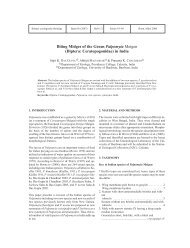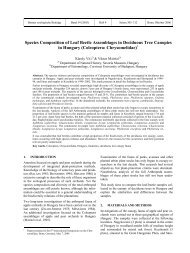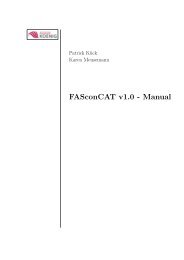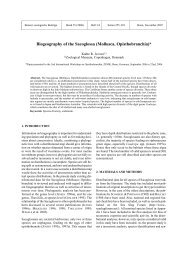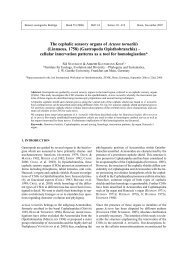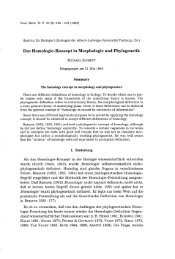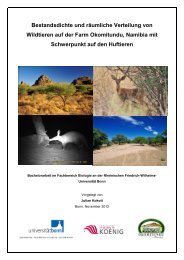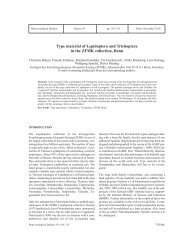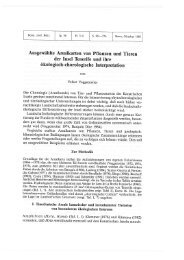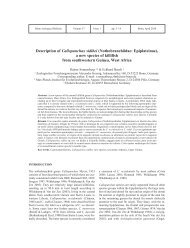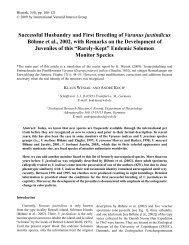Islands Between the Realms: A Revised Checklist of the ...
Islands Between the Realms: A Revised Checklist of the ...
Islands Between the Realms: A Revised Checklist of the ...
Create successful ePaper yourself
Turn your PDF publications into a flip-book with our unique Google optimized e-Paper software.
112 André KOCH et al.: A <strong>Revised</strong> <strong>Checklist</strong> <strong>of</strong> <strong>the</strong> Herpet<strong>of</strong>auna <strong>of</strong> <strong>the</strong> Talaud Archipelago, Indonesia<br />
ish black, ventral side ei<strong>the</strong>r uniform light grey or dark<br />
grey with more or less light mottling, toes with weak light<br />
transverse bands.<br />
The Talaud population may represent a member <strong>of</strong> <strong>the</strong><br />
Callulops (Phrynomantis) robustus group (R. GÜNTHER,<br />
pers. comm.). The genus Callulops inhabits <strong>the</strong> Moluccas,<br />
New Guinea and surrounding island groups with 17<br />
recognized species (FROST 2007), two <strong>of</strong> which (C.<br />
boettgeri and C. dubius) are found on Halmahera. According<br />
to MÉHELY (1901) and PARKER (1934) C. boettgeri is<br />
characterized by large triangular discs at fingers and toes,<br />
while those <strong>of</strong> <strong>the</strong> fingers are larger than those <strong>of</strong> <strong>the</strong> toes.<br />
Having <strong>the</strong> finger tips pointed and those <strong>of</strong> <strong>the</strong> toes slightly<br />
enlarged, fingers and toes without webbings, no maxillary<br />
teeth, a smooth skin above and beneath, <strong>the</strong> nostril<br />
much closer to <strong>the</strong> tip <strong>of</strong> <strong>the</strong> snout, tympanum feebly distinct<br />
and about half <strong>the</strong> diameter <strong>of</strong> <strong>the</strong> eye, presence <strong>of</strong><br />
a supratympanic fold (but absent in MZB Amph. 11443<br />
and 11500, possibly due to preservation), our voucher<br />
specimens resemble more <strong>the</strong> second Callulops species<br />
known from Halmahera, C. dubius (BOETTGER 1895b).<br />
However, in contrast to <strong>the</strong> latter species, <strong>the</strong> first finger<br />
is longer than <strong>the</strong> second in <strong>the</strong> Talaud specimens. It cannot<br />
be ruled out that <strong>the</strong> Talaud specimens represent two<br />
distinct species due to <strong>the</strong>ir differences in ventral color pattern<br />
and <strong>the</strong> presence or absence <strong>of</strong> a supratympanic fold.<br />
Ranidae<br />
Limnonectes cf. modestus (Boulenger, 1882)<br />
Material examined: MZB Amph. 11478 (AK073), 11493<br />
(AK068), 11494 (AK050), MZB Amph. 11497 (AK051).<br />
Additional material: Probably ZMA 8870 (5 spec.),<br />
“Taloek, island North <strong>of</strong> Halmaheira” (= Talaud!),<br />
coll. M. WEBER 1900<br />
Distribution: Based on material collected by <strong>the</strong> Siboga<br />
Expedition <strong>of</strong> Max WEBER (six specimens according to<br />
van Kampen [1907], but only five according to <strong>the</strong> ZMA<br />
online catalogue; see ‘additional material’), VAN KAMPEN<br />
(1907) was <strong>the</strong> first to record L. modestus from <strong>the</strong> Talaud<br />
<strong>Islands</strong> without indicating <strong>the</strong> exact locality. This<br />
species is also known from North Sulawesi, <strong>the</strong> type locality,<br />
and some islands in <strong>the</strong> Moluccas. The Philippine<br />
populations have been removed from <strong>the</strong> synonymy <strong>of</strong> L.<br />
modestus (INGER 1954).<br />
Ecology: While two adult voucher specimens were collected<br />
near a small stream in <strong>the</strong> vicinity <strong>of</strong> <strong>the</strong> village<br />
Lirung, <strong>the</strong> third (MZB Amph. 11493) was found as road<br />
kill next to a coconut plantation.<br />
Morphology & Taxonomy: All three adult specimens<br />
closely resemble in morphology and coloration. SVL<br />
58.6–63.6 mm, TiL 32.7–33 mm, head as broad as long<br />
or broader than long; vomerine and maxially teeth present;<br />
nostril nearer to tip <strong>of</strong> snout than to eye; tympanum<br />
distinct, 3/4 <strong>the</strong> diameter <strong>of</strong> <strong>the</strong> eye; strong supratympanic<br />
fold; finger tips pointed, those <strong>of</strong> <strong>the</strong> toes with very<br />
small discs; first finger slightly longer than second; fingers<br />
without webbings, toes nearly fully webbed; dermal<br />
fringe along <strong>the</strong> outer side <strong>of</strong> fifth toe present; inner palmar<br />
tubercle swollen, outer missing; inner metatarsal tubercle<br />
present, outer missing; skin smooth without ridges<br />
or tubercles. Coloration dorsally olive-green to brownish<br />
with little dark spots; tympanum partly blackish;<br />
supratympanic fold above tympanum black; upper lips<br />
with dark vertical bars; limbs without dark cross bars; posterior<br />
part <strong>of</strong> thighs blackish with orange marbling; ventral<br />
side ei<strong>the</strong>r unicolored whitish cream under head and<br />
chest, limbs and posterior half <strong>of</strong> venter orange, particularly<br />
towards vent (MZB Amph. 11494), or underside<br />
whitish with grey mottling under head and many grey<br />
spots and blotches on chest and venter. Probably three females<br />
were collected without vocal sacs. Accordingly, <strong>the</strong><br />
specimens lack bony processes in <strong>the</strong> lower jaw as typical<br />
for males <strong>of</strong> L. modestus. A fourth subadult specimen<br />
<strong>of</strong> Limnonectes was collected in a narrow gorge with a<br />
small riverine (Fig. 4). SVL 27.3 mm, TiL 13.8 mm, head<br />
slightly longer than broad. Morphologically, this specimen<br />
resembles <strong>the</strong> three adult specimens, except for <strong>the</strong> indistinct<br />
supratympanic fold. However, it shows differences<br />
in color pattern. Thus, <strong>the</strong> dorsal side is brown with distinct<br />
darker cross bars and blotches on <strong>the</strong> limbs; a dark<br />
cross bar between <strong>the</strong> eyes is present, too; <strong>the</strong> distinct marbling<br />
on <strong>the</strong> posterior part <strong>of</strong> <strong>the</strong> femurs is missing.<br />
MENZIES (1987) suggested that populations <strong>of</strong> Sulawesi<br />
and Ceram might represent different taxa. Fur<strong>the</strong>r investigations,<br />
morphologically and genetically, are needed to<br />
clarify <strong>the</strong> taxonomic identity <strong>of</strong> <strong>the</strong> Talaud populations.<br />
SAURIA<br />
Agamidae<br />
Bronchocela cristatella (Kuhl, 1820) (Fig. 7)<br />
Material examined: MZB Lac. 5080 (AK057).<br />
Additional material: ZMA 18832 (4 spec.), Gunung<br />
Doeata (= Mt. Duata), Karakelong, coll. H. J. LAM, 1926;<br />
ZMA 18833, Lirung, Salibabu, coll. H. J. LAM, 1926;<br />
MCZ R-45770, -771, Karakelong, coll. FAIRCHILD Garden<br />
Expedition, 1940




